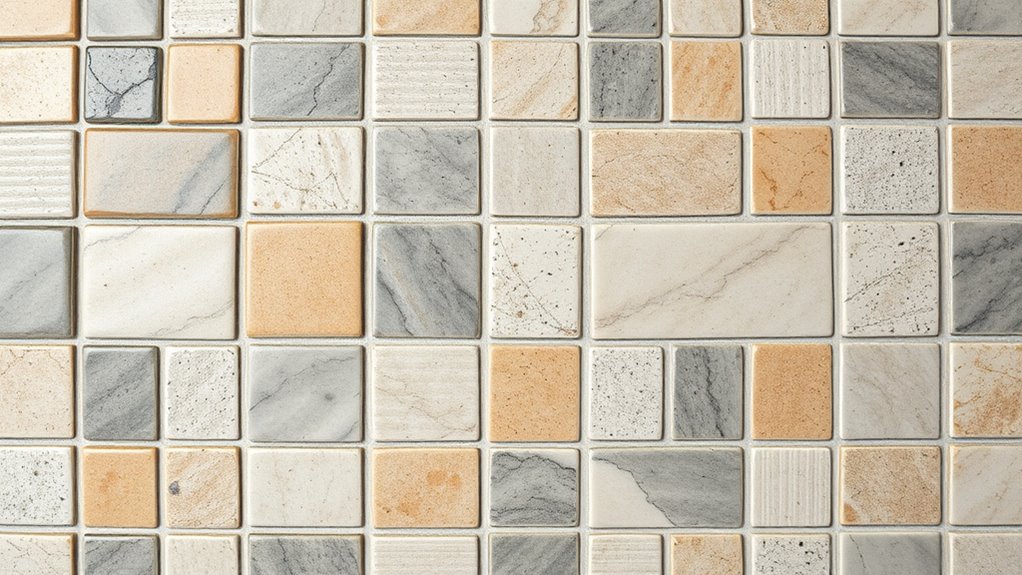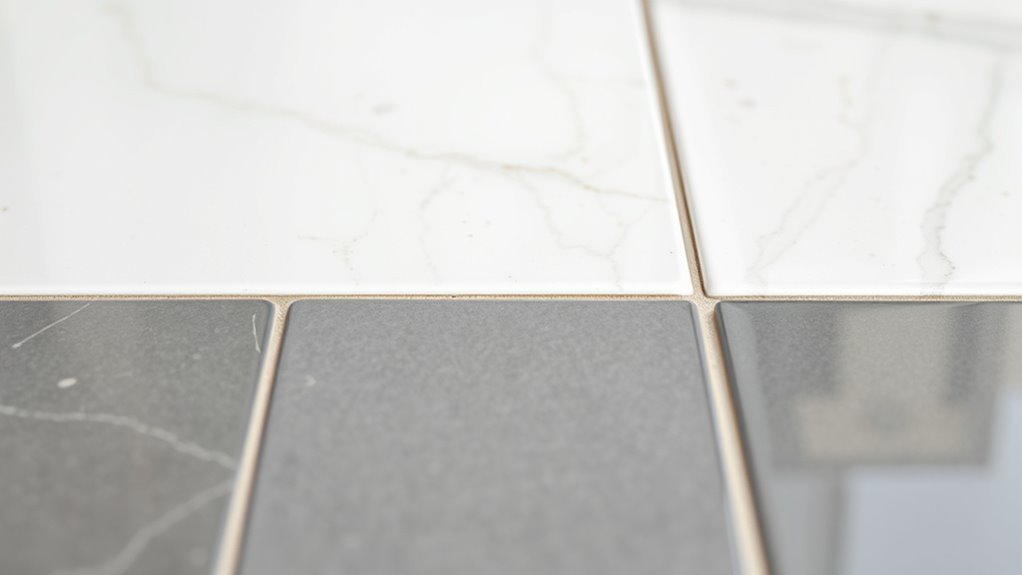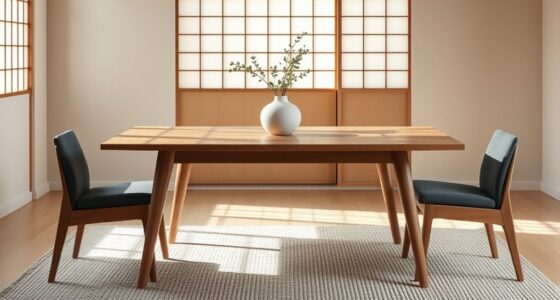When choosing grout colors for your tile, consider the overall look you want to create. Matching grout offers a seamless, modern feel, while contrasting grout highlights patterns and adds visual interest. Darker shades hide stains better and suit busy areas, while lighter tones can make your space appear larger. Think about maintenance, style, and mood to make the best choice. Keep exploring to discover how to perfectly match your tiles and achieve your ideal space.
Key Takeaways
- Match grout to tiles for a seamless, modern look; contrast for emphasis and visual interest.
- Consider the room’s style and mood—light grout for openness, dark for coziness.
- Think about maintenance needs—darker grout hides stains; lighter grout shows dirt more easily.
- Test grout samples in different lighting to ensure color harmony before installation.
- Balance aesthetic with practical factors like activity level and moisture exposure for lasting satisfaction.

Selecting the right grout color can considerably enhance the overall look of your tile installation. When choosing a grout color, you’re fundamentally deciding how your tiles will come together visually, affecting both the style and mood of your space. One of the key considerations is color contrast. If you opt for a grout that closely matches your tile, your installation will have a seamless, uniform appearance. This approach works well if you want a sleek, modern look where the focus stays on the tile pattern itself. Conversely, selecting a grout color that contrasts sharply with your tiles creates a more defined and striking visual. High contrast grout can emphasize the shape and layout of your tiles, making patterns pop and adding depth to your design. It’s ideal if you want your tile work to stand out or if you’re working with smaller tiles that might otherwise blend together.
Beyond aesthetics, grout maintenance plays a significant role in your decision. Lighter grout tends to show dirt, stains, and discoloration more quickly, requiring more frequent cleaning to maintain its fresh appearance. On the other hand, darker grout can hide grime better, reducing the need for constant upkeep. If your space sees a lot of activity or moisture—like kitchens, bathrooms, or outdoor areas—you might prefer a darker grout for easier maintenance. Also, consider the type of grout you choose; stain-resistant options are available that can make upkeep even simpler, regardless of the color. Additionally, understanding personality traits associated with different choices can help you select a grout that aligns with your style and maintenance preferences.
Another aspect to keep in mind is the overall style of your space. Neutral or matching grout colors tend to blend seamlessly, creating a cohesive, understated look that lets your tiles shine. If you’re aiming for a more artistic or bold design, contrasting grout can serve as a visual accent, adding character and interest. Remember, the right grout color can also influence the perceived size of your space. Light grout can make a room feel larger and more open, while dark grout can create a cozy, intimate atmosphere.
Ultimately, your choice should balance your aesthetic goals with practical considerations like grout maintenance. Take the time to test a few options by laying out samples and observing how they look with your tiles in different lighting conditions. This way, you’ll make an informed decision that enhances your space’s beauty and remains easy to care for over time.
Frequently Asked Questions
How Does Grout Color Affect Tile Maintenance?
Grout color considerably impacts how easy you find cleaning and maintaining your tile. Light grout shows stains and dirt easily, requiring more frequent cleaning techniques, while darker grout offers better stain resistance, making maintenance simpler. Choosing a grout color that hides dirt helps you keep your tile looking fresh longer. With the right color, you’ll spend less time on cleaning techniques and enjoy a cleaner, more attractive space.
Can Grout Color Change Over Time?
Grout color can change over time like a chameleon adapting to its surroundings. Exposure to sunlight, moisture, and dirt can cause color fading and stain resistance to weaken. While high-quality grout resists staining and maintains its hue longer, no grout is immune to aging. You might notice slight shifts in shade, especially in high-traffic areas or humid spaces, but proper sealing and maintenance can slow this natural transformation.
What’s the Best Grout Color for Small Spaces?
For small spaces, you should choose a grout color that matches your tile to create a seamless look, making the area appear larger. Opt for a neutral shade with minimal contrast, which helps avoid visual clutter. Consider grout durability to guarantee longevity, especially in high-traffic areas. A color that blends well and offers strong durability will keep your space looking fresh and cohesive over time.
How to Choose Grout Color for Patterned Tiles?
Imagine your patterned tiles like a vibrant painting; your grout color acts as the frame. To highlight the pattern, opt for a contrasting grout color that makes each design pop. If you want a seamless look, choose a grout shade that matches the tile’s dominant color for pattern matching. Consider your overall style—bold contrast for modern spaces or subtle hues for a softer, cohesive appearance.
Does Grout Color Impact the Overall Room Design?
Yes, grout color impacts the overall room design by influencing color contrast and aesthetic harmony. When you choose a contrasting grout, it makes the tile pattern pop, creating a bold look. On the other hand, matching grout blends seamlessly, offering a subtle, cohesive appearance. Your choice guides the room’s mood and style, so consider how you want the space to feel and look when selecting the grout color.
Conclusion
Think of choosing grout colors like painting a masterpiece. The right hue can make your tiles sing or blend into the background, creating harmony or bold contrast. Just as a painter selects shades to evoke emotion, you select grout to enhance your space’s vibe. Trust your instincts, experiment a little, and remember: the perfect grout color ties everything together, turning your tile project into a work of art you’ll love to live with.








